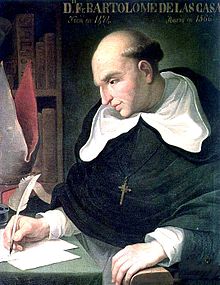Bartolomé de las Casas
 The Cathlic Dominican friar Bartolomé de las Casas, (1484-1566 A.D.), was a 16th-century Spanish He became the first resident Bishop of Chiapas Mexico. His extensive writings, the most famous being A Short Account of the Destruction of the Indies and Historia de Las Indias, chronicle the first decades of colonization of the West Indies and focus particularly on the atrocities committed by the colonizers against the indigenous peoples.
The Cathlic Dominican friar Bartolomé de las Casas, (1484-1566 A.D.), was a 16th-century Spanish He became the first resident Bishop of Chiapas Mexico. His extensive writings, the most famous being A Short Account of the Destruction of the Indies and Historia de Las Indias, chronicle the first decades of colonization of the West Indies and focus particularly on the atrocities committed by the colonizers against the indigenous peoples.
Bartolomé de las Casas saw several hieroglyphic books about 1540 containing the history of the people’s origins and religious beliefs, written with “figures and characters by which they could signify everything they desired; and that these great books are of such astuteness and subtle technique that we could say our writing does not offer much of an advantage”. (Las Casas 1958, 346)
Bartolomé de Las Casas was particularly impressed by the fact that the Maya could write “everything they desired.” The Maya were, in fact, the only people in the New World who had a writing system at the time of the Spanish conquest which had this capability.
Maya hieroglyphs are partly phonetic (glyphs which stand for individual sounds) and partly logographic (picture writing in which a glyph stands for an entire word or concept). Because of their phonetic nature, Maya glyphs may be placed together to form any word which can be thought or spoken. There is no evidence that such a script was ever developed or used in the Guatemalan highlands after the Late Preclassic, however, the authors of the Popol Vuh made clear that they based their writings on an imported text from the Maya lowlands. It is likely that some 23 few scribes at the Quiché court were familiar enough with such books in their possession that they could read them in at least a cursory way. (Sacred Book of the Quiché Maya People. Translation & Commentary by Allen J. Christenson, www.mesoweb.com/publications/Christenson/PopolVuh.pdf.)
Additional Information;
Bartolomé de las Casas, Wikipedia